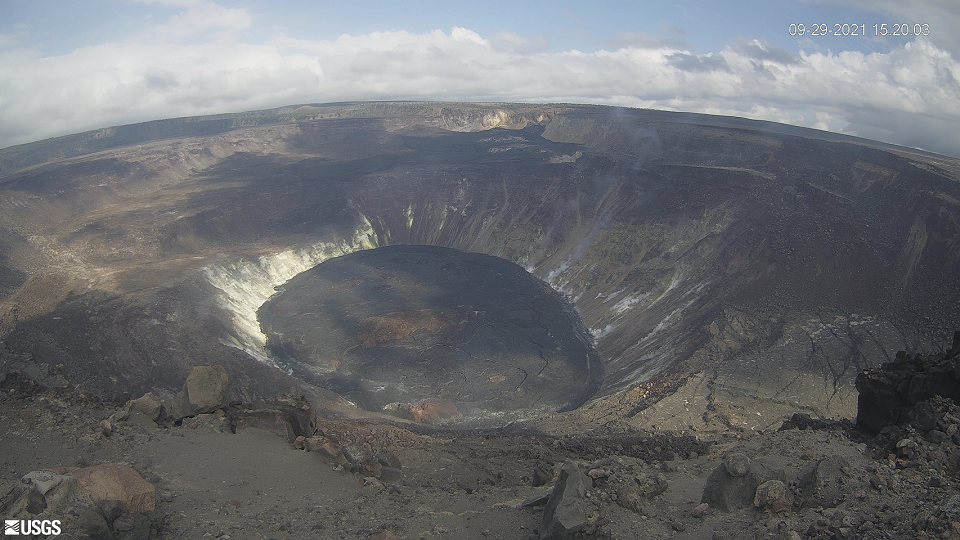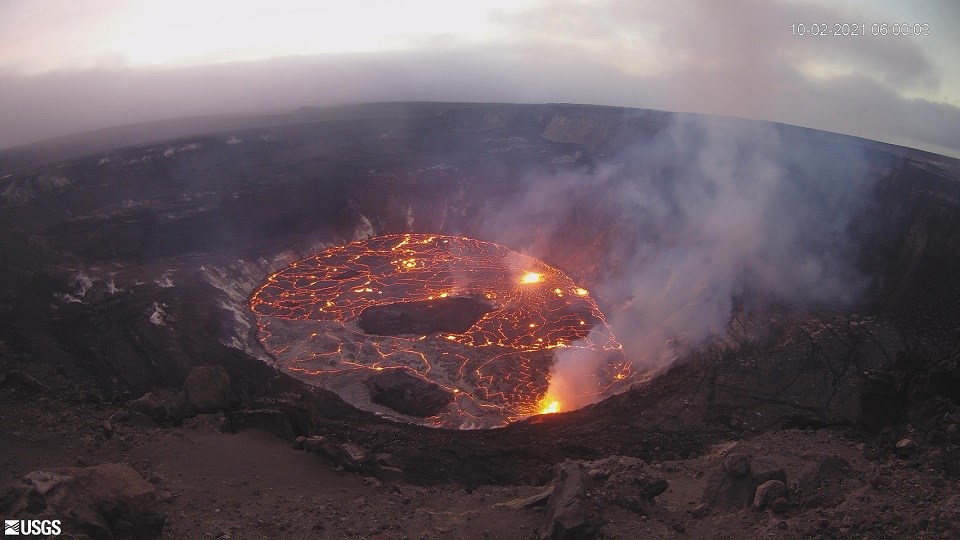How Long Count Kilauea Volcano Continue to Erupt
Kīlauea volcano began erupting on September 29, 2021, at approximately 3:21 p.m. in Halema'uma'u crater. The new eruption began four months after the end of the previous Kīlauea eruption which ended in May. Current data from Hawaiian Volcano Observatory (HVO) indicate that the activity is likely to continue and remain contained within Halemaʻumaʻu crater. Lava continues to erupt from a single vent in the western wall producing a voluminous lava lake. Visit the eruption viewing webpage for information on how to plan your visit.
Visit our keyboard shortcuts docs for details
- Duration:
- 1 minute, 12 seconds
The lava lake in Halema'uma'u, at the summit of Kīlauea, remains active. On Wednesday, June 15, a small collapse of a portion of the lake rim created a dusty plume and lake agitation, including waves that traveled across the lake surface.
Before and after eruption comparison


Left image
KWcam image taken on September 29, 2021, at 3:20 p.m. HST. This image shows the lava lake that was active within Halemaʻumaʻu crater at the summit of Kīlauea from December 2020 until May 2021 just prior to a new eruption beginning.
Credit: USGS webcam image
Right image
KWcam image taken on October 2, 2021, at 6 a.m. HST. This image shows the ongoing eruption within Halemaʻumaʻu crater at the summit of Kīlauea. The eruption began the afternoon of September 29, 2021.
Credit: USGS webcam image
Visit our keyboard shortcuts docs for details
- Duration:
- 47.4 seconds
This timelapse sequence shows one image per day over the past two months from the B1cam webcam on the east rim of Halema'uma'u, at the summit of Kīlauea. The images show that the floor of Halema'uma'u has been growing endogenously. Lava is supplied beneath the solidified crust that forms the surface of the crater floor, lifting the surface in a manner similar to inflating an air mattress. In addition to endogenous growth, sporadic lava flows overplate the crust and also contribute to growth.
Eruption Chronology
Eruption chronology courtesy of the USGS Hawaiian Volcano Observatory
- On September 29, at 3:30 pm HST, three fissures opened east of the large island near the center of the lava lake that was active within Halemaʻumaʻu crater from December 2020 until May 2021. The new fissures generated lava flows on the surface of the previous lava lake surface.
- At approximately 4:43 p.m. HST, another vent opened on the west wall of Halemaʻumaʻu crater.
- The new eruption is generating a vigorous plume of volcanic gas. The volcanic gas, which includes sulfur dioxide (SO2), interacts in the atmosphere with oxygen, moisture, dust, and sunlight over minutes to days and forms volcanic air pollution, or VOG, which can be transported downwind. An estimated 85,000 tonnes of sulfur dioxide emissions were generated during the first day of the eruption, dropping to an estimated 20,000 tonnes per day on September 30 and 12,900 tonnes per day on October 1.
- Lava was slightly visible from multiple open areas of the park on the night of September 30.
- By October 1, the growing lava lake within Halemaʻumaʻu is estimated to have risen roughly 89 feet (27 meters) since the eruption started on September 29. The estimated area of the lake is about 134 acres (54 hectares).
- On October 2, USGS field crews measured lava fountain heights of approximately 7 meters (7.7 yds) from the main vent and 1.1-2.2 yards (1-2 meters) from the southernmost vents. Occasional fountain height bursts have been observed over the past 24 hours, including a burst this morning with estimated heights of 55-66 yards (50-60 meters).
- Lava continued to erupt from multiple vents within Halemaʻumaʻu through October 3 and 4. During that time, the lava lake rose approximately 6.6 feet (2 meters). Due to the location of vents, the lava lake is not level across its surface; areas closer to the vents are higher in elevation. Sustained lava fountain heights of 16-33 feet (5-10 meters) were observed.
- On October 6 observers noted that the lava lake level rose approximately 2 meters (7 ft) over the past 24 hours with a total rise of about 31 meters (102 ft) since lava emerged on September 29. The total thickness of lava filling Halemaʻumaʻu is now 256 meters (840 ft ) with a lake surface elevation of approximately 774 meters (2539 ft) above sea level. The west vent continues to have the most vigorous fountain with sustained lava fountain heights of about 14–15 meters (49 ft). The lava lake has risen above the base of the vent and the fountain has built a spatter rampart around most of it. Another vent continues to be active in the southern part of the lake with lava fountain heights averaging 3 meters (10 ft). Due to the location of vents, the lava lake is not level across its surface. Areas closer to vents in the west and south part are about 1–2 m (3–7 ft) higher in elevation compared to the north and east end of the lava lake. Crustal foundering, a process by which cooled lava crust on the lake surface sinks into the hot underlying lake lava, is observed on the active surface of the lava lake. The active lava lake surface is perched 1 meter (3 ft) above a 20-meter-wide (66 ft) ledge that extends outward to the Halemaʻumaʻu crater wall.
- October 10, 2021. A magnitude 6.2 earthquake hit off-shore southwest of the island of Hawaiʻi, rattling residents. According to the Hawaiian Volcano Observatory, the earthquake was centered about 27 km (17 miles) south-southeast of Nāʻālehu at a depth of 35 km (22 mi). The earthquake had no significant observable affect on Kīlauea volcano except for a few rock falls.
- October 15, 2021. The activity of the lava lake within Halemaʻumaʻu crater decreased over the past week. Lava continues to fill the western half of the lava lake from the erupting western fissure. Much of the eastern half of the lake surface has cooled and formed a solid crust. The lava lake measures approximately 1,035 m (3,396 ft) long in the east–west direction and 745 m (2,444 ft) wide in the north–south direction. SO2 gas emission rates remain elevated and were measured at approximately 5,400 tonnes per day.
- October 19, 2021. USGS Hawaiian Volcano Observatory scientists estimated 4.2 billion gallons of lava (15.9 million cubic meters) have filled the lava lake since the summit eruption began three weeks ago on September 29. The lava lake has filled the crater to about 46 meters (151 ft) since lava emerged on September 29.
- October 24, 2021. The rising lava lake was oberved for the first time from Kīlauea Overlook and continues to be visible from Uēkahuna and near Keanakāko'i.
- October 26, 2021. Low lava fountains a few meters (yards) tall were common. Sometimes fountains would reach up to 12 meters (39 ft). The cone was measured at 25 meters (82 ft) above the active lava lake surface. Lava is ponding within the cone and flows down the spillway—which is about 7 meters (23 ft) long—supplying lava into the lake below.
- November 1, 2021. The northeastern end of the lava lake has now risen high enough to start covering the lowest portion of the down-dropped block on the north side of Halema'uma'u. The down-dropped block several hundred feet beneath the main caldera floor was formed during the 2018 Kīlauea caldera collapse.
- November 8, 2021. USGS Hawaiian Volcano Observatory reported that a deflation event is occurring at the summit of Kīlauea volcano. There is no spatter or fountaining lava coming out of the west vent. Volcanic gas emissions decreased dramatically, down to 250 tonnes/day compared to 2500 tonnes/day last week.
- November 12, 2021. Activity has returned to levels observed prior to the brief decrease in activity.
- November 13, 2021. Small collapse of the spatter cone at night within Halemaʻumaʻu crater provides better views of the fountains in the west vent.
- November 15, 2021. A lava break-out from the edge of the lava lake allowed lava to flow onto the surface of the down-dropped block on the north side of Halema'uma'u
- December 4, 2021. The rate of lava decreased sharply, potentially marking a pause in the current eruption. A small portion of the vent cone collapsed at about 5PM, though there appeared to be no effect on the eruption directly due to the collapse.
- December 6, 2021. All of the instrumental data and observations indicate the eruption is paused. This is the fourth and largest such slow down or pause since the eruption began on September 29 and none of the prior events lasted more than 24 hours before resumption of normal eruptive activity. The summit has showed slight re-pressurization, but tremor levels are below previous levels during the eruption.
- December 6, 2021. The west vent resumed with normal eruptive activity around 7 p.m. The summit showed an increase of deformation followed by eruptive activity.
- December 14, 2021. The eruption resumed following a short pause on December 13.
- December 21, 2021. Rapid deflationary tilt began yesterday, December 20, 2021 at about 11 AM and flattened out early this morning. Volcanic tremor associated with the eruption has virtually ceased and earthquake activity remains below background.
- December 22, 2021. The summit eruption of Kīlauea volcano resumed ending a 2-day pause in activity.
- December 28, 2021. The summit eruption of Kīlauea volcano resumed ending a 2-day pause in activity.
- January 19, 2021. The ongoing eruption underwent nine main pauses, which first started occurring a little over a month ago. There may have been a few smaller and shorter pauses, when the lava lake didn't completely crust over, starting as early as November.
- April 14, 2021. The eruption has produced 17.5 billion gallons since it started. Lava has risen another 99 meters (325 feet) since it began in September. The current size of the lava lake surface is 219 acres. For perspective, the former lava lake that drained out in the 2018 summit collapse was about 10 acres.
- June 17, 2021. The eruption has produced 24.4 billion gallons since it started. Lava has risen 423 feet (129 m) and is 262 acres in size.
Source: https://www.nps.gov/havo/learn/nature/september-2021-eruption.htm
0 Response to "How Long Count Kilauea Volcano Continue to Erupt"
Post a Comment